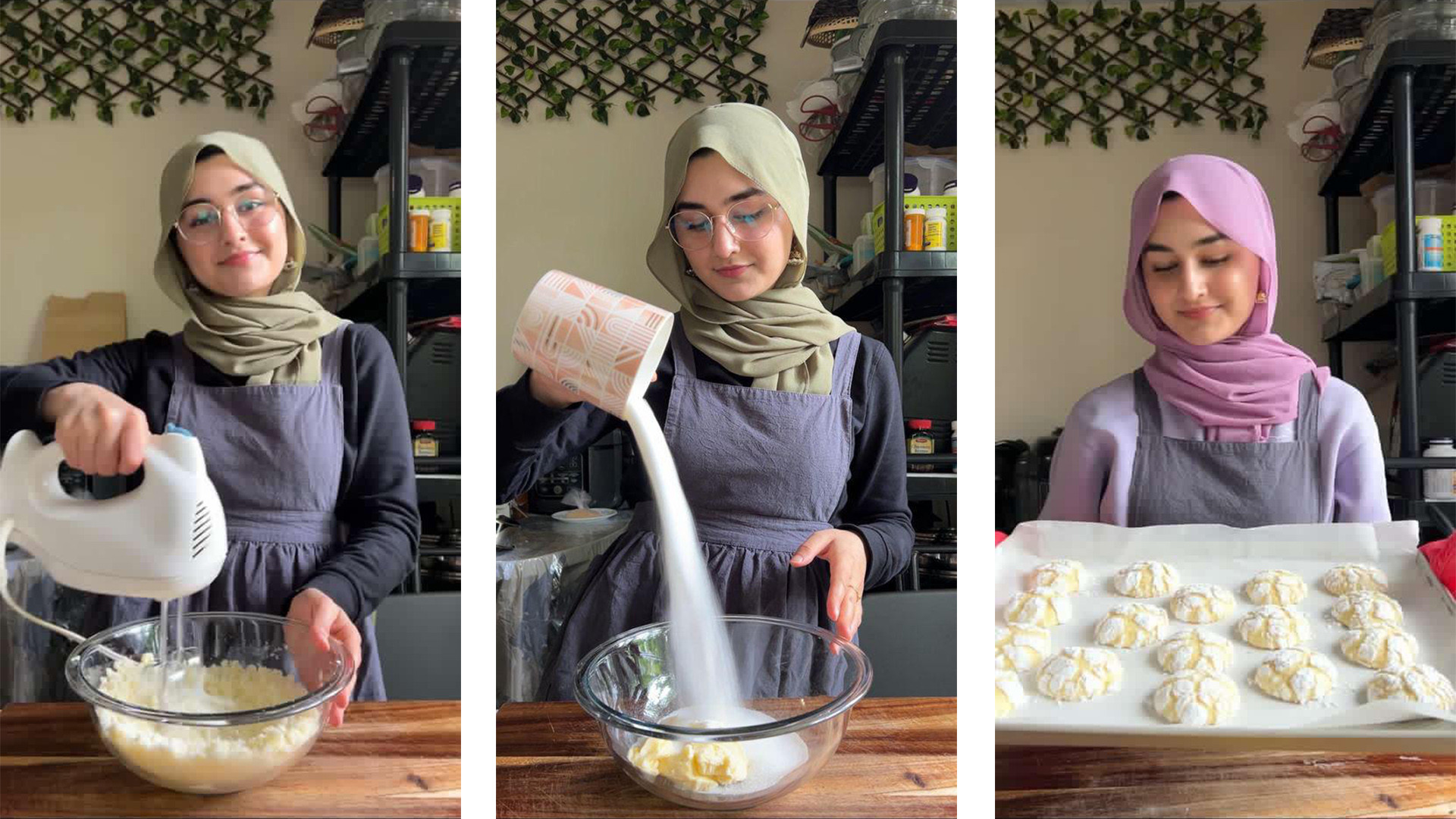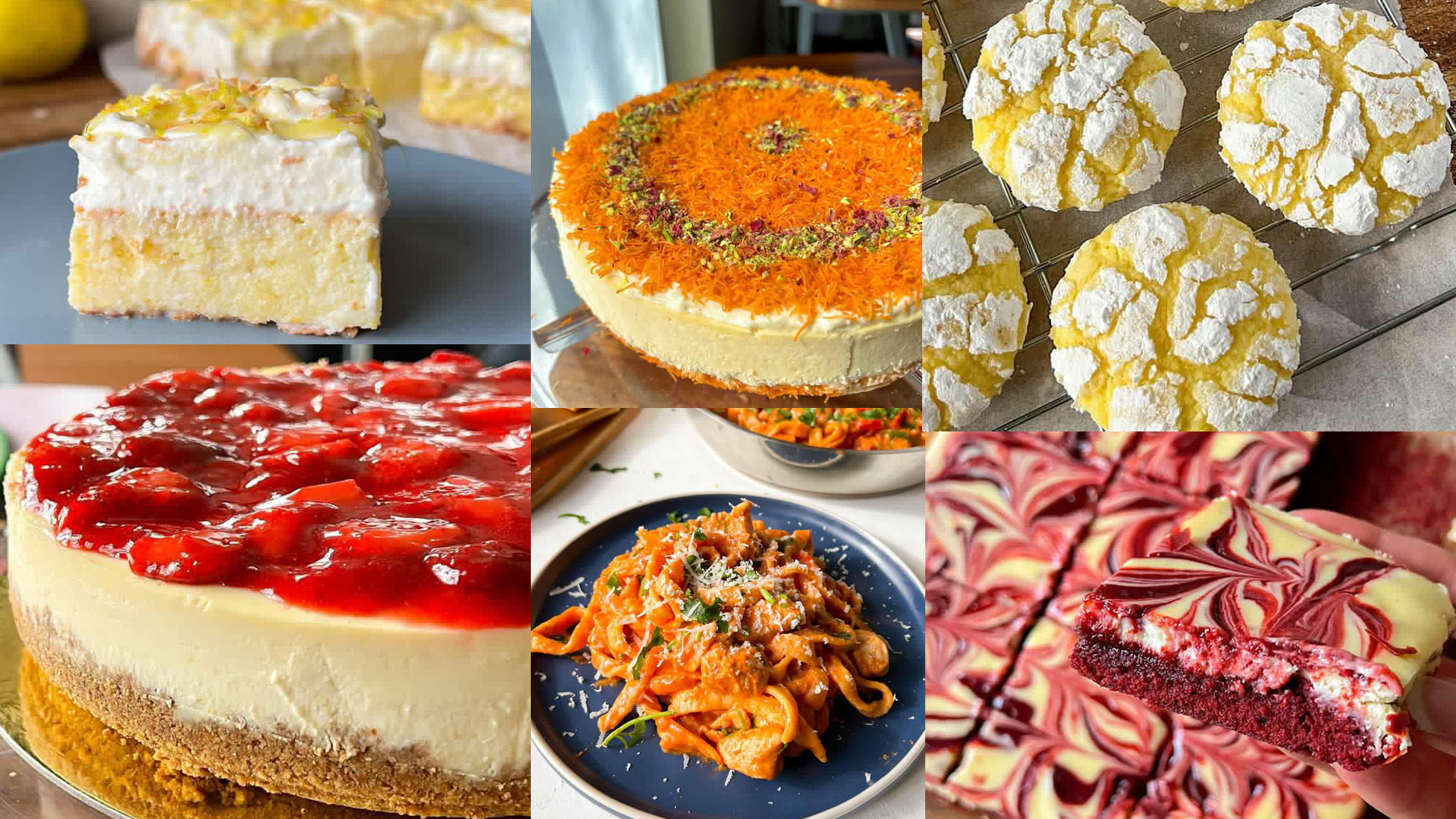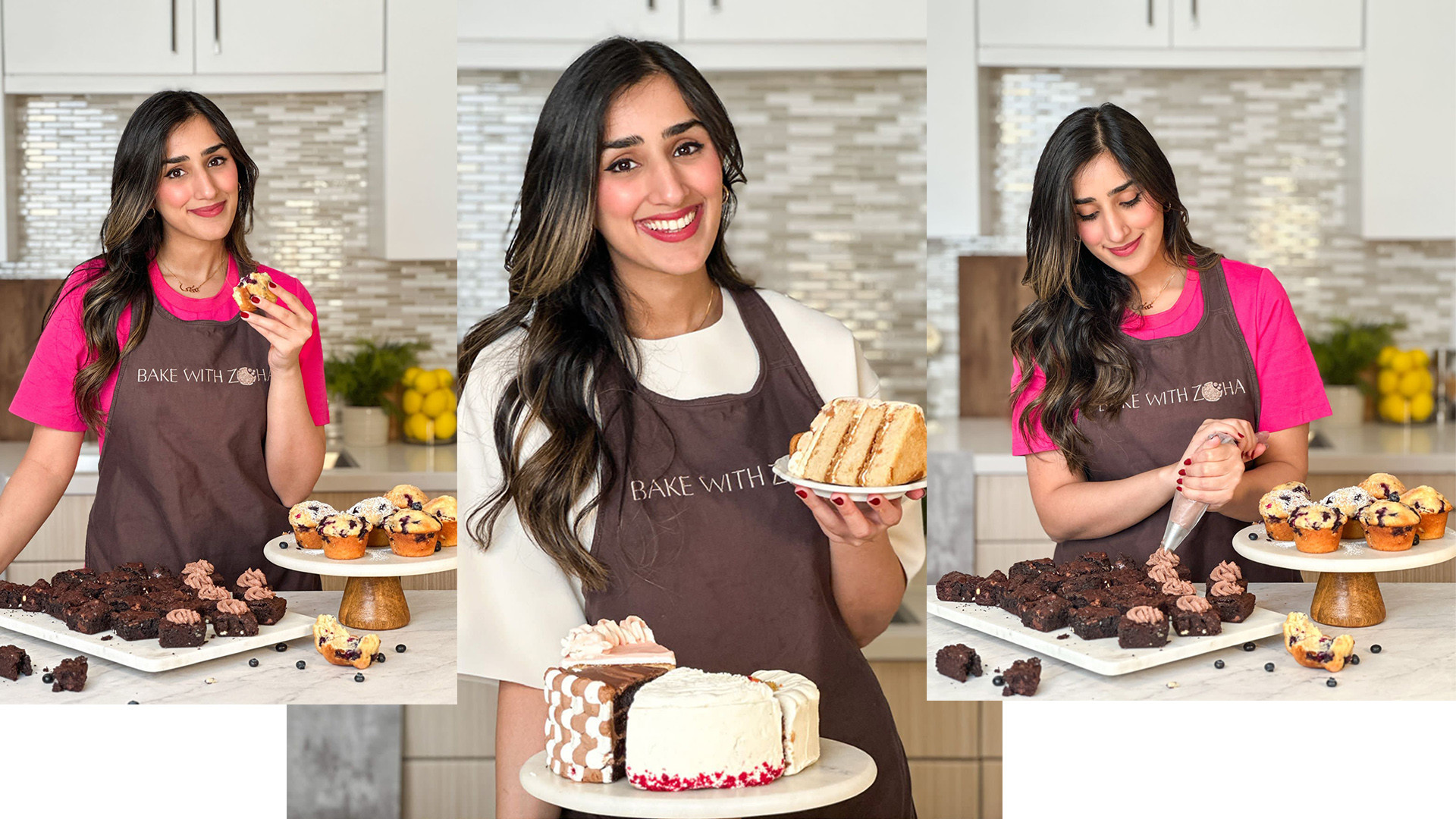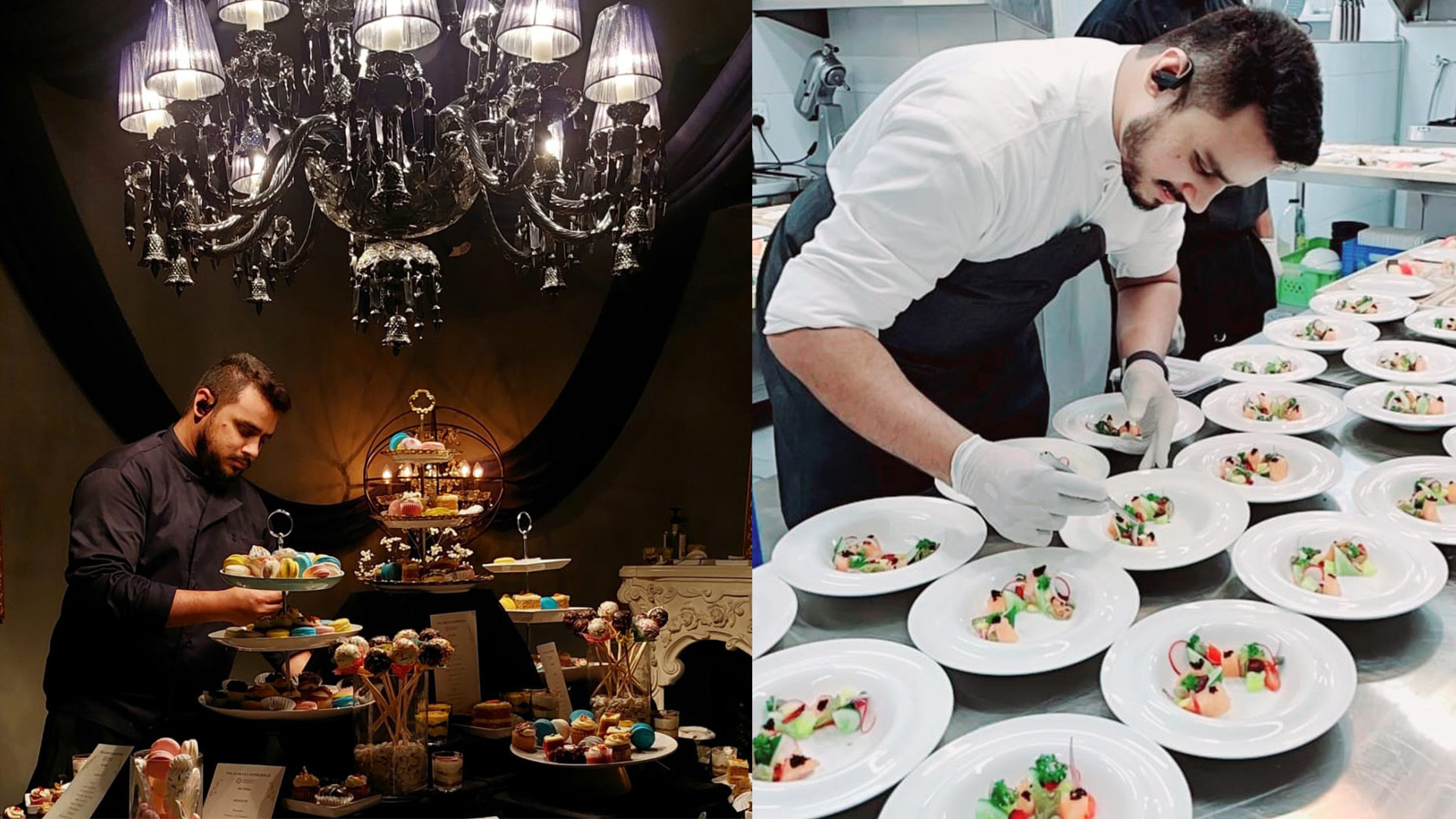Nabeah Wahab pours a mixture of coconut, condensed and regular milk into a bowl, making sure her camera angle doesn’t alter with movement. With almost five hundred thousand followers on Instagram, a glitchy video wouldn’t please viewers. She is recording a new recipe, having balanced the taste of sweet coconut mixed with tangy lemon juice to reinvent the traditional, cliched version of tres leche cake. When she finally posts the reel on her Instagram account, her followers react with glee.
“Thank you for sharing this,” one of them states. Others drool at the sight of spoon sliding into the soft, creamy sponge. “What would we do without you?”

Nabeah, like many others in her industry, is a home chef and food content creator, based in Vancouver, BC. With recipes that span from cookies to kunefe to miso garlic salmon, Wahab has tapped into different cuisines to gain a massive fan following.
“I loved cooking since I was a child,” she says. “I would help my mom make desserts for parties. But what catapulted my passion to another level was the lack of halal food options available in Canada (where I live), so I created various recipes to satisfy my food cravings. Then came the pandemic and in lockdown, with more time available for cooking, I decided to take the plunge and start an Instagram page.”
Aptly titled ‘Nombeah’, her Instagram profile handle mixes the most casual word for food indulgence with her nickname, “Beah.”
Food blogs and food writers having existed in the food industry for a long time now. However, with the rise of social media platforms and the internet, this industry has evolved significantly.
In today’s food media landscape, influencer marketing has become a crucial component. Specifically, food brands and restaurants are increasingly collaborating with food influencers on Instagram. Being a platform centred around photo-sharing, it provides the perfect visual space for sharing enticing food images and recipe visuals.

The saying “You eat with your eyes” perfectly captures the essence of this phenomenon. The ever-growing number of food influencers on Instagram is a testament to the impact of visually appealing content. Partnering with food influencers offers numerous benefits, including enhancing brand visibility, testing new food concepts, and more as they can serve as excellent brand ambassadors for various culinary businesses, such as apps and nutritional companies.
It's not just the rise of influencer marketing that has contributed to the popularity of food influencers on Instagram. Audiences are increasingly focused on healthy eating, constantly searching for easy-to-make yet delicious recipes and exciting dining experiences.
Food is an immensely popular niche on social media, and influencers provide the perfect means to harness its popularity. Why do influencers work so effectively? The answer lies in trust. Research shows that 61% of consumers trust influencer recommendations, compared to only 38% who trust brand-produced content. Incorporating food influencers into your strategy can expand your reach and foster meaningful relationships with your audience. They bring a sprinkle of credibility that helps your brand connect with social media users, while also infusing a wealth of creative flavour.
Another Pakistani baker and food content creator Zoha Malik, or ‘Bake with Zoha’ on Instagram, currently lives in California. “When I was a child, my mother and grandmother cooked to express themselves, so I gravitated towards that as well,” she says. “I would make cakes and brownies which got a lot of compliments in school. Naturally, with work and life commitments, I stopped baking the way I used to.”
The pandemic came as a blessing in disguise for Malik too. “In lockdown, my life had come to a standstill,” she says. “I thought about what I could do to get rid of the unhappiness I was facing. So, I took two weeks off from work and focused on what made me happy ― baking. I discovered that I felt more fulfilled, more at peace with myself, and eventually, in 2022, I made a social media page for myself to share my recipes with followers, thinking I could probably get a couple of thousand at most.” As of June 2023, Malik’s page is close to three hundred thousand followers.

Wahab believes that currently food trends have become quite diverse and multi-cultural in Pakistan, where the hotpot trend has sprung up and Korean restaurants such as Magal and Naerok are being widely appreciated.
“I’ve specifically seen mango mocha, a Japanese dish, a lot on social media,” she says. “You take a mango slice and cover it in mochi, which is a chewy rice cake made of glutinous rice flour. I’ve been meaning to create a recipe for my blog.”
Before mango mochi, Wahab introduced people were introduced to Nigerian fufu (a pounded meal made from the fermented cassava plant) and egusi (a soup made with meat, seafood, tofu, and greens).
“With increased globalisation, people are craving recipes from different cultures, which is fantastic,” says Wahab.

Malik agrees about people wanting to sample food from a variety of cuisines. “There has been a rise in niche foods, be it gluten-free, plant-based, vegan, or sugar-free foods,” she says. Both the women are clear that globalisation has led to cultures and recipes being amalgamated, and also people are more aware of food allergies and ‘healthier’ food options.”
Both of them also ascertain that social media is a powerful tool that is a ‘must-use’ f food content creators and chefs want to prosper.
“People use social media more for information than they would a search engine,” says Malik, who has left her corporate job, this year, to focus full time on baking and food content creation. “My career now is absolutely dependent on social media. I find that people focus on visuals, use Tiktok and Instagram to find new recipes, and get inspiration from others to create their own recipes … the whole dynamic has changed.”
Since 2020, when Wahab started creating content on social media, she feels the platform has treated her with utmost respect and appreciation. “One follower commented the following ‘I know when I see a hijabi, the food will be great!’ after seeing my hair covered. I thought that was sweet.
Still, a few followers express that since I am a woman, to cook is what I am destined to do, and that makes me indignant. My actions are a result of my wish to cook, not because it is something I am supposed to be doing as a woman,” she says as she shook her head.
Shah Jilani is a male Pakistani chef, who is more popular for working at the ‘Izakaya’ restaurant in Karachi. He is noticeable for his fire show, shared by influencers when they visit the restaurant, where he uses a flame thrower to dramatically live cook steaks. Being a male chef, his understanding of the industry is different.
“Luckily for me, I watched my father, uncles, and grandfather cooking for the family, which is quite rare in our patriarchal society,” he says.

In 1998, Jilani started home cooking, and then attended culinary school to become a certified chef. “In all my years working, I feel society doesn’t take male chefs as seriously as they would if that same male were a doctor, or say, an engineer. I feel the role of chef, or baker, or cook, has been taken for granted to be for women. It’s not even that male chefs are rare. There are lots of them, in restaurants, on television. You don’t see them on social media so much, and I think that has led to this stereotyped societal viewpoint.”
Izakaya, a restaurant in Karachi where Jilani is head chef, is renowned for its multicultural menu, spanning from Japanese to Continental cuisines. “Many foreign dignitaries come to our restaurant for its lavish courses and exquisite fire and smoke shows,” Jilani says. “Not surprisingly, we have had all kinds of visitors wanting to try our new, Pakistani fusion menu. We have recreated the traditional gol gappas into a fusion meal with Japanese tatas (a form of sushi), we have used conventional sugarcane juice as drink shots between courses, and we have even deconstructed the typical ‘naan’ that we use with gravies into a new, ‘prawn on naan’ that our guests love.”
In this way, young chefs such as Jilani changing the concept of desi food and are very cleverly putting Pakistani food onto the world map.
“I guess no matter how much you travel, at the end of the day, regardless of how much sushi you’ve tried, or caviar you’ve had, at the end of the day people miss the taste of original, Pakistani food,” he says. “That’s also a reason why we do live fire shows; Pakistanis love smoky taste in their food and the ever-slightly charred beef taps into the memories of their childhood food items. Even people from foreign embassies love this taste.”
Moreover, this new breed of food content creators is vastly different from veteran chefs that Pakistan’s population grew up watching. Food connoisseurs like Shireen Anwer and Chef Zakir, famous for their live recipes on television and recipe books followed by mainstream audiences, were more traditional in their approach.
“I think that now, people are realising that consumers don’t gravitate only to products, but also to content creators that they can connect to,” says Malik. “Even within the food industry, it is about putting yourself out with your product, being open about yourself, your culture and values, what inspired you to create a certain recipe, and why you are invested in the food you cook. People used to follow recipes, but now, with social media, they follow the person sharing them.”
Moreover, with the world shifting towards non-traditional, multicultural recipes, there is sure to be an increase in the availability of ingredients.
“I feel that there will be a definite growth in plant based, sustainable and eco-friendly farming,” Malik asserts.
“According to the UN’s Food and Agricultural Organisation, there will be a 60 percent increase in agricultural output in order to feed our population by 2050,” adds Jilani. “People have begun to focus on increased sustainability, less wastage, and more plant-based rather than only meat-based consumption. Even our current food consumption and farming practices are unsustainable, so there is bound to be a noticeable change.”
In economic terms, with global price rises, and a galloping 38% inflation rate in Pakistan, food and groceries are becoming more and more expensive, so therefore, recipe creation costs far more than it used to.
“Buying groceries for testing and filming a new recipe is costlier, and if the test fails, I have to redo the whole process until I get it right,” says Wahab.
Jilani feels that the pandemic was very restrictive when it came to restaurant-based chefs, but since 95% of food orders were delivered to homes, that led to the rise of home chefs and food content creators. “It is another matter that economic instability has caused disruptions in marketing and proper budgeting, but I hope we cross the bridge safely and soon,” he says.
For Malik, it was a risky decision to quit her job and pursue a career in content creation. “Considering how unstable the economy is right now,” says Malik. “I am in a good place thankfully, but in general there is an economic slowdown which has led to food content creators being affected. Brands are more careful about where they put their money, budgeting, partnerships, and marketing. This has slugged the industry in general.”
Still, with this new field of food content creators and home chefs learning to navigate their space within the industry, there is so much room for more people to discover their niche.
“If someone has a passion for food, they should start with what they enjoy and branch out from there,” says Wahab. “I would say to that person: if you feel overwhelmed, take inspiration from creators online and try their material, until you find your own style and footing,”
Malik emphasises on not overthinking. “I would say, don’t overthink your decision or wait for the perfect moment,” she says, tapping on a video of a cheesecake she has made, to which various people have sent direct messages on Instagram. “More importantly, use social media in your approach. You must leverage all the tools you can. Tiktok, Youtube, Instagram. “See, the audience gives feedback with enthusiasm.” She clicks and the screen goes blank. “You can’t escape this tool now.”
Mehreen Chawla is a freelance contributor and can be reached at mehreennaveed2009@hotmail.com. All facts and information are the sole responsibility of the writer
